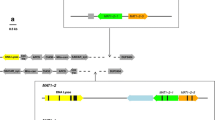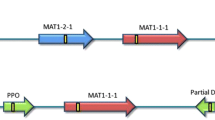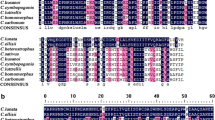Abstract
Phaeosphaeria (anamorph Stagonospora) nodorum is the most serious fungal pathogen of wheat in the West Australian (WA) wheat belt and is a diallelic heterothallic loculoascomycete. Its population genetics has received considerable attention. A recent study, which sampled isolates from diverse locations worldwide, has indicated that the mating-type idiomorph MAT1-1 is considerably more frequent than MAT1-2 in many populations. To investigate this, we developed PCR primers that amplify each idiomorph. In a sample of 23 isolates cultured from ascospores collected in the field, nine amplified DNA with the MAT1-1 primers and 14 amplified DNA with the MAT1-2 primers. The virulence of a MAT1-2 isolate was comparable with MAT1-1 isolates. Although these sample sizes are small, we suggest that this result is consistent with the presence of equal numbers of both mating types in populations of ascospores in WA.
Similar content being viewed by others
References
Arseniuk E, Goral T and Scharen AL (1998) Seasonal patterns of spore dispersal of Phaeosphaeria spp. and Stagonospora spp. Plant Disease 82: 187–194
Bathgate JA and Loughman R (2001) Ascospores are a source of inoculum of Phaeosphaeria nodorum, P. avenaria f. sp. avenaria and Mycosphaerella graminicola in Western Australia. Australasian Plant Pathology 30: 317–322
Bennett RS, Yun S-H, Lee TY, Turgeon BG, Arseniuk E, Cunfer BN and Bergstrom GC (2003) Identity and conserva-tion of mating type genes in geographically diverse isolates of Phaeosphaeria nodorum. Fungal Genetics and Biology 40: 25–37
Bhathal JS, Loughman R and Speijers R (2003) Yield reduction in wheat in relation to leaf disease from yellow (tan) spot and septoria nodorum blotch. European Journal of Plant Pathology 109: 435–443
Caten CE and Newton AC (2000) Variation in cultural charac-teristics, pathogenicity, vegetative compatibility and electro-phoretic karyotype within field populations of Stagonospora nodorum. Plant Pathology 49: 219–226
Dai Q, Arseniuk E, Cunfer BM, Cui K and Ueng PP (2001) Segregation, aggressiveness and sexuality in Phaeosphaeria nodorum. Phytopathology 91: S20
Faulkner MJ and Colhoun J (1976) Aerial dispersal of pycnidio-spores of Leptosphaeria nodorum. Phytopathologische Zeitschrift 86: 357–360
Halama P (2002) Mating relationships between isolates of Phaeosphaeria nodorum, (anamorph Stagonospora nodorum) from geographical locations. European Journal of Plant Pathology 108: 593–596
Halama P and Lacoste L (1991) Determinisme de la reproduction sexuee du Phaeosphaeria (Leptosphaeria) nodorum agent de la septoriose du ble I. Heterothallism et role des microspores. Canadian Journal of Botany 69: 95–99
Halama P and Lacoste L (1992) Determinisme de la reproduction sexuee du Phaeosphaeria (Leptosphaeria) nodorum agent de la septoriose du ble II. Action de la temperature et de la lumiere. Canadian Journal of Botany 70: 1563–1569
Keller SM, McDermott JM, Pettway RE, Wolfe MS and McDonald BA (1997) Gene flow and sexual reproduc-tion in the wheat glume blotch pathogen Phaeosphaeria nodorum (anamorph Stagonospora nodorum). Phytopathology 87: 353–358
Loughman R and Thomas GJ (1992) Fungicide and cultivar control of Septoria diseases of wheat. Crop Protection 11: 349–354
McDonald BA, Miles J, Nelson LR and Pettway RE (1994) Genetic variability in field populations of Stagonospora nodorum. Phytopathology 84: 250–255.
Murphy NE, Loughman R, Appels R, Lagudah ES and Jones MGK (2000) Genetic variability in a collection of Stagonospora nodorum isolates from Western Australia. Australian Journal of Agricultural Research 51: 679–684
Turgeon BG (1998) Application of mating type technol-ogy to problems in fungal biology. Annual Reviews of Phytopathology 36: 115–137
Wechmar and von MB (1966) Investigation on the survival of Septoria nodorum Berk. on crop residues. South African Journal of Agricultural Sciences 9: 93–100
Zahn J, Kema GHJ, Waalwijk C and McDonald BA (2002) Distribution of mating type alleles in the wheat pathogen Mycosphaerella graminicola over spatial scales from lesions to continents. Fungal Genetics and Biology 36: 128–136
Author information
Authors and Affiliations
Rights and permissions
About this article
Cite this article
Solomon, P., Parker, K., Loughman, R. et al. Both Mating types of Phaeosphaeria (anamorph Stagonospora) nodorum are Present in Western Australia. European Journal of Plant Pathology 110, 763–766 (2004). https://doi.org/10.1023/B:EJPP.0000041565.42836.c1
Issue Date:
DOI: https://doi.org/10.1023/B:EJPP.0000041565.42836.c1




